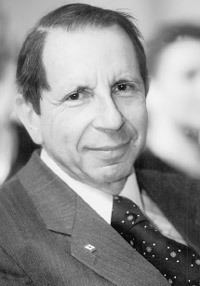Name Sergei Slonimsky Role Composer | Parents Mikhail Slonimsky | |
 | ||
Books Solo for 3 Piano Vol 2 Music for 6 Hands Sergei Slonimsky Education Saint Petersburg Conservatory (1950–1955), Moscow Conservatory (1943–1945) People also search for Nicolas Slonimsky, Mikhail Slonimsky, Anton Rubinstein | ||
Sergei slonimsky ivan the terrible overture 1993 wmv
Sergei Mikhailovich Slonimsky (Russian: Серге́й Миха́йлович Слони́мский, born August 12, 1932, Leningrad) is a Russian and Soviet composer, pianist and musicologist.
Contents
- Sergei slonimsky ivan the terrible overture 1993 wmv
- Sergei slonimsky virineya
- Biography
- Music and style
- Operas
- Ballets
- References
Sergei slonimsky virineya
Biography
He is a son of Soviet writer Mikhail Slonimsky and a nephew of the Russian-American composer Nicolas Slonimsky. He studied at the Musical College in Moscow from 1943 until 1950. From 1950 Slonimsky was at the Leningrad Conservatory. He studied composition under Boris Arapov, Vissarion Shebalin and Orest Yevlakhov, polyphony under Nicolai Uspensky and piano under Anna Artobolevskaya, Samari Savshinsky and Vladimir Nielsen. Slonimsky is a professor at the St. Petersburg Conservatory. While the majority of his students are Russian, Slonimsky teaches a large percentage of the international composition students at the Conservatory from countries including: Colombia, Korea, China, Italy, Germany, Iran and the United States.
Music and style
Sergei Slonimsky has composed more than a hundred pieces: 5 operas, 2 ballets, 13 symphonies and works in all genres of chamber, vocal, choral, theatre and cinema music, including Pesn' Volnitsy (The Songs of Freedom, for mezzo-soprano, baritone and symphony orchestra based on Russian folk songs, 1962), A Voice from the Chorus, a cantata set to poems by Alexander Blok, Concerto-Buffo, Piano Concerto (Jewish Rhapsody), Cello Concerto, 24 preludes and fugues, etc.
Mostly eclectic, he has experimented with a folkloric style as well as with 12-tone techniques and new forms of notations. He has also used forms and styles of jazz and neo-romantic music.
